Athol writes to his mother about receiving her letters, the heat and flies, his promotion and a Turkish plane which flew over and dropped leaflets. He mentions his mate, Norm Marshall, who was also promoted (see more about Norm in my 9 June blog-post).
The letters are now in pencil and he does well to keep things neat and legible in the trying conditions.
The letters are now in pencil and he does well to keep things neat and legible in the trying conditions.
Dear Mater,
Many thanks for yours numbered 10.11.12. No.4 was the last previous. I believe there are about 80 chasing me though they should be here by now. I've had two letters from Aunt May also 4 pairs of socks, a letter from Mrs Folley and a p.c. from W.J.A Fant (sp.) as well as a few others.
I've been back here just over a week now arriving last Sunday week and am attached to 'D' company. We are in the trenches but it is pretty quiet as a rule, just a bit of sniping a few shells. Yesterday a 6" shell landed behind one of our observation groups and buried them all, 7 in number. No one was hurt much, though of course it shook them up a bit.
We officers do 3 hours on and 6 off and we also have to 'stand to' arms from 3-4 and on any alarm etc. We work sentry groups under an N.C.O. six men, doing 1 hour on and 2 off. We are not able to get a wash whilst in the trenches. I haven't had one for over a week though I've had 2 shaves and generally clean my teeth every day. When we come out of the trenches we will be able to get a swim though it is more dangerous on the beach than in the firing line as a rule owning to shrapnel.
Norm Marshall is now a 1st Lieut also me. 15 of old 'F' company have got commissions since the show started. Not a bad record.
I had a letter from Bill (eldest brother Arthur Parker Adams) and see in the papers that they have had rain. I've only received one Australasian and one Referee, May 8. (Athol was a keen sportsman and his step father was sending him these journals which were eagerly sought after).
It is pretty hot up here now and the flies are awful. There weren't any, I believe, until after that big Turkish attack and then the heaps of dead Turks brought them. There are lots of rumours, or 'Furphys' fresh ones every day, sometimes that we are going to England for a rest, sometimes to Lemnos and sometimes to Egypt. Also about every subject under the sun.
A Turkish plane dropped some leaflets the other day which dropped into our trenches. They sent them to us on a Bomb. They were a proclamation promising us good treatment if we surrendered! We're considering it. I don't think. I'm on duty now so I'll knock off.
Love to all enquiring friends.
Yours lovingly,
Athol

















